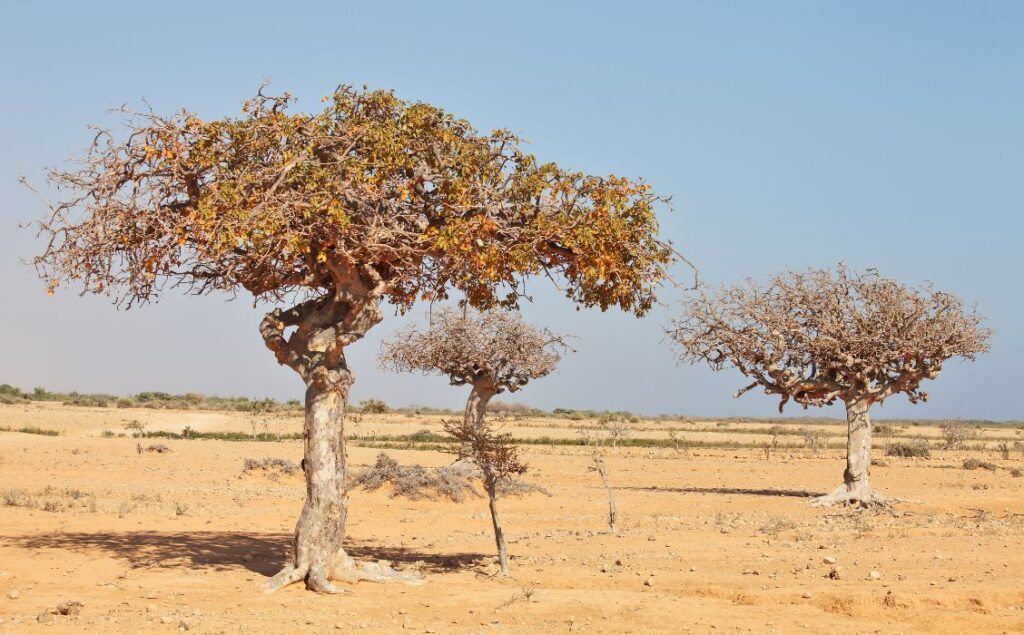The myrrh plant (Commiphora myrrha) is a dioecious tree from the Burseraceae family, renowned for its aromatic resin, which has been used for millennia in medicinal, religious, and perfumery practices. Native to northeastern Africa, this species naturally grows in countries such as Somalia, Ethiopia, and parts of Kenya, as well as in the Arabian Peninsula, particularly in Oman and Yemen. Adapted to arid environments, myrrh thrives on rocky slopes and desert valleys, often amid sparse Acacia (Vachellia sp.) vegetation. It grows at altitudes ranging from 250 to 1,300 meters (820 to 4,265 feet), preferring shallow, predominantly limestone-rich soils, with an annual rainfall between 230 and 300 mm (9 to 12 inches).
Its botanical name reflects its defining characteristics: Commiphora derives from the Greek kommis (gum) and phora (bearer), indicating its resin-producing ability, while myrrha originates from the Arabic mur (المر), meaning “bitter,” a reference to the resin’s distinctive taste.

Myrrh can grow as either a shrub or a small, thorny tree, reaching up to 4 meters (13 feet) in height. Its trunk is short, thick, and smooth, covered in bark that varies in color—ranging from silvery, white, reddish, to bluish-gray. This bark peels off in thin flakes, revealing a green inner layer that not only protects the plant but also enables photosynthesis. This adaptation allows the plant to sustain its metabolism even when it sheds its leaves during dry periods. Its branches are gnarled and end in thorns, contributing to its unique and sculptural appearance. The highly valued resin is harvested by making incisions in the bark, from which a viscous liquid exudes and hardens upon contact with air, forming small, translucent yellowish granules.
Myrrh leaves are small and trifoliolate, with a gray-green or glaucous hue. The petiole varies in length from 0.04 to 0.4 inches (1 to 10 mm), supporting three leaflets that come in different shapes—elliptical, spatulate, or lanceolate. Their sizes range from 0.24 to 1.73 inches (6 to 44 mm) in length and 0.12 to 0.79 inches (3 to 20 mm) in width. The base of the leaflets may be slightly tapered, rounded, or even truncated, while the apex can be either rounded or acute. The margins can be entire or serrated, usually with up to six small teeth on each side. The veins are subtle, typically numbering three to four, without prominent relief on the leaf surface.

Myrrh produces dichasial cymes as its inflorescences, with male flowers arranged in small clusters of two to four. Measuring between 0.12 to 0.16 inches (3 and 4 mm) in length, these flowers have sparse glandular structures and are supported by tiny, light brown bracteoles, about 0.02 to 0.03 inches (0.5 to 0.7 mm) in both length and width. These structures often fuse at the base, forming a fragile and easily detachable ring.
The floral receptacle is shaped like a calyx, while the petals are oblong and delicate, tapering into a recurved tip, measuring approximately 0.18 inches (4.5 mm) in length and 0.06 inches (1.5 mm) in width. The stamens are slender, with filaments ranging from 0.05 to 0.06 inches (1.2 to 1.4 mm), and minuscule anthers measuring between 0.04 to 0.05 inches (1.0 and 1.2 mm) in length. After flowering, the plant produces fruit in the form of small, ovoid, and flattened drupes, which often develop in pairs on articulated peduncles. Each fruit has a small beak-like projection at the tip and measures between 0.08 to 0.16 inches (2 and 4 mm) in length. Inside, the seeds are smooth, featuring slight surface protuberances.
Throughout history, myrrh has held great cultural and economic significance. It was one of the gifts presented to the infant Jesus, according to the biblical account, and had already been used by ancient civilizations long before that. Around 1100 BCE, the Sumerians employed the resin to treat dental infections and intestinal parasites. In ancient Egypt, it was essential in religious rituals and mummification due to its preservative properties and distinctive fragrance. Its use as incense and perfume also made it extremely valuable, being traded by caravans across the Middle East and the Mediterranean. Today, myrrh remains present in religious ceremonies and the cosmetics industry, in addition to being the subject of scientific studies on its therapeutic properties.

The resin of Commiphora myrrha has traditionally been used in medicine to treat wounds, inflammations, oral ulcers, and microbial infections. Phytochemical studies have identified compounds such as monoterpenoids, sesquiterpenoids, diterpenoids, and triterpenoids in the resin, which contribute to its antimicrobial, anti-inflammatory, and antioxidant properties. Recent research suggests a potential antitumor effect, particularly against gynecological cancer cells. However, despite its traditional uses and scientific advancements, further studies are needed to confirm its efficacy in various medical applications.
Although not commonly used in landscaping, myrrh can be an excellent choice for xerophytic gardens and reforestation projects in arid regions. It should not be confused with False myrrh, of the species Tetradenia riparia. Its drought resistance and uniquely textured and colored trunk give it a sculptural aspect, evoking the aesthetics of desert landscapes. However, due to the presence of thorns on its branches, it is advisable to plant it in low-traffic areas to prevent accidents. It can also be grown in pots, making it an interesting option for bonsai cultivation.

Successful myrrh cultivation requires full sun, with at least six hours of direct light per day. The soil should be well-drained and can range from sandy to clayey, as long as it does not retain excessive moisture. The plant exhibits good tolerance to nutrient-poor soils, provided the pH is neutral to slightly alkaline. As it is highly adapted to drought, it does not require frequent watering. Once established in the soil, irrigation can be minimized, recommended only when the soil is completely dry. Excess moisture is one of the primary risk factors, potentially leading to root rot.
Fertilization should be applied moderately during the growing season, using balanced fertilizers to supply any deficiencies. Regarding maintenance, occasional pruning can be beneficial to remove damaged branches or guide the plant’s growth. Due to its regenerative capacity, C. myrrha quickly forms calluses after cuts, facilitating its recovery.

Regarding pests and diseases, myrrh is a highly resistant species when grown under suitable conditions. However, excessive soil moisture can make the plant susceptible to fungal diseases and root rot, emphasizing the importance of well-drained substrates and controlled watering.
Myrrh propagation can be carried out both by seeds and cuttings, with the latter being the most efficient option. Seeds have low germination rates, typically ranging from 1.8% to 8%, due to natural dormancy. To improve success rates, mechanical or chemical scarification is recommended, followed by sowing in a well-drained substrate maintained at a temperature between 80°F to 84°F (27°C and 29°C). When germination occurs, it takes between 6 and 14 days. On the other hand, propagation through hardwood cuttings has a significantly higher success rate. It is advisable to collect cuttings of at least 12 inches (30 cm) at the end of the growing period. After cutting, they should be left to dry for a few days to form a callus before planting in a sandy, well-drained substrate. With moderate watering and minimal interference, the cuttings root within a few months, making this an effective alternative for species multiplication.


